Are you interested in canoeing but need help knowing where to start? Understanding the different parts of a canoe is a great place to begin. Canoes have a rich history and have been used for transportation, hunting, and recreation for centuries.
Over time, the design and construction of canoes have evolved, resulting in lighter, stronger, and more efficient boats. The parts of a canoe include the bow, stern, hull, keel, deck, gunwales, thwarts, yoke, seats, and stems. Every part of a canoe’s performance and functionality is crucial.
In this blog post, we’ll explore all the important parts of the canoe and its significance in detail. So, let’s dive in and learn more about this fascinating watercraft.
Key Takeaways On Parts Of A Canoe
Why is it important to know the different parts of a canoe – Knowing the different parts of a canoe is important for safety, maintenance, and performance. It helps identify hazards, maintain the canoe, and select the right one for your needs.
Parts of a Canoe
Bow: The front end of the canoe
Stern: The back end of the canoe
Hull: The body of the canoe that sits in the water
Keel: The outer strip on the bottom of the canoe that runs from bow to stern
Deck: A triangular surface where the boat’s gunwales are joined at the bow and stern
Gunwales: The top edge of the canoe that runs along the sides
Thwarts: Crossbars connecting the canoe’s sides, providing rigidity and support
Yoke: A crossbar used to carry the canoe on your shoulders
Seats: Where the paddlers sit
Stems: The curved ends of the canoe
Belly: The bottom of the canoe
Stern vs Bow of Canoe
Canoe Bow
The bow is the front end of a canoe. It plays a crucial role in the canoe’s performance and functionality.
- Shape: The bow typically features a pointed or tapered shape, allowing it to cut through the water efficiently.
- Contact with Water: As the first part of the canoe that makes contact with oncoming water, the shape of the bow helps the canoe cut or glide through the water ahead.
- Stability: The bow’s design contributes to the canoe’s overall stability, ensuring a balanced and controlled ride.
- Seats and Anchoring: The bow often houses a seat for one of the paddlers in a two-person or greater capacity canoe like freighter canoe. It also provides points for anchoring the canoe, tying it to a dock, or hanging canoe on wall for storage.
- Portage Handle: Many canoes have a handle in the bow, making it easier for two people to lift and carry the canoe during portage.
Canoe Stern
The stern is the back end of a canoe. It serves important functions that contribute to the canoe’s performance.
- Shape: The stern is designed to reduce turbulence and assist with the canoe’s ability to move forward with minimal effort.
- Steering: The stern is where most of the steering is done, allowing the paddler to control the canoe’s direction.
- Seating: The stern often houses a seat for one of the paddlers in a two-person or greater capacity canoe. It is positioned closest to the flotation tank.
- Portside and Starboard Side: The stern is where the canoe’s portside (left side when facing towards the bow) and starboard side (right side when facing towards the bow) are located.
- Construction: The stern must be designed in a certain shape to help the canoe move smoothly through the water and so the canoe material.
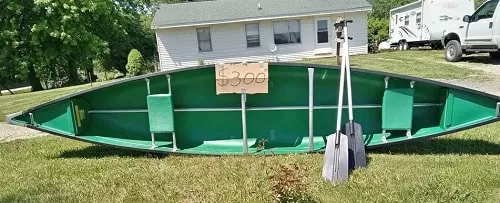
Canoe Thwart
A thwart is a strut that stretches horizontally from one side of a canoe to the other. It is an essential part of the structure of a boat, providing strength and rigidity.
Thwarts brace the edges of the canoe from side to side, resisting forces pushing in or pulling out the sides of the hull. Two thwarts are normally positioned around 1/3 and 2/3 of the way from the stern of a canoe towards the bow in a 2-person canoe.
As much weight will be placed directly on the gunwales (sides of a canoe), you will frequently find a thwart behind the front paddler’s seat.
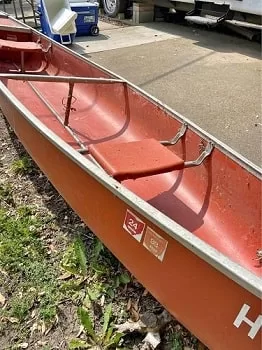
Thwarts offer canoe stiffness and allow a canoeist who needs to paddle a place to sit. Thwarts for canoes can be constructed of plastic, aluminum, or wood.
Canoe Hull
Flat hulls
Canoes with flat hulls have a bottom that is flat with little curves, which makes them particularly stable on calm water.
However, secondary stability suffers as a result of this initial stability. Canoes with flat bottoms are vulnerable to wind, waves, and even tilting. It is challenging to prevent capsizing if initial stability is gone.
Rounded hull
Canoes with rounded hulls have a curved bottom that provides good secondary stability. This means they are more stable when leaning to one side, making them ideal for rougher waters. However, they are less stable when upright, making them more difficult to balance.
Shallow arch hull
Shallow arch hulls are made to provide paddlers with both the freedom of a round hull and the stability of a flat hull. They are growing in popularity because they successfully balance initial and secondary stability. They are also more maneuverable than flat-bottomed canoes.
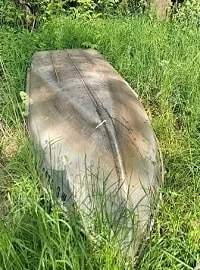
V-shaped hull
V-shaped hulls are planing hulls and are the most common type for powerboats. They are designed to rise and ride on top of the water at higher speeds. V-shaped hulls are ideal for fast-moving water and are less stable than other hulls.
Multi-Chine Hull
Multi-chine hulls have multiple angles or chines along the bottom of the canoe. This design provides stability and tracking, making them ideal for longer trips and rougher waters. They are also more efficient than other hulls, allowing faster speeds with less effort.
Canoe Keel
The keel is part of a canoe that runs along the hull’s centerline from bow to stern. It is a long, narrow strip of material that provides stability and helps the canoe track straight in the water.
Keels were originally integrated into canoe designs for structural purposes to keep the canoe upright. Nowadays, keels are optional and can be added to a canoe for additional stability and tracking.
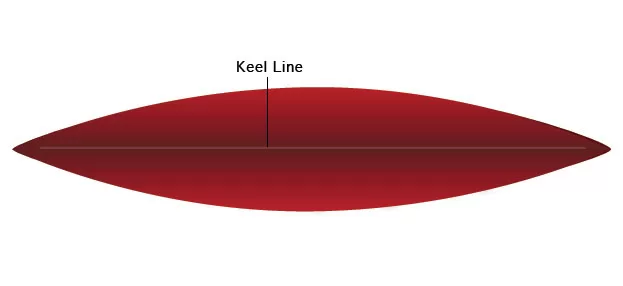
There are different types of keels, including shoe keels, that act to protect the hull from abrasion. Some people prefer canoes with keels because they are easier to glide down a river with minimum correction. Others prefer canoes without keels because they are more efficient and can be turned more easily.
How does the canoe keel affect the performance of the canoe?
The canoe keel has a limited impact on performance. It has little effect on straight-line tracking and maneuverability, which are mainly determined by the hull’s shape.
There are two types of keels, tee and shoe, and the hull design and angle of the canoe sides have a greater impact on stability, dryness, and ease of paddling the canoe.
Canoe Gunwale/Gunnel
The canoe gunwale, also known as the gunnel, is the wide top edge of a hull that runs from the bow to the stern on either side of a canoe. It serves several functions, including:
- Reinforcement: The gunwale reinforces the canoe’s structure, providing strength and rigidity to the hull. It helps maintain the canoe’s shape and prevent it from flexing or warping.
- Mounting Point: The gunwale provides a convenient place to mount various canoe accessories and components of the canoe, such as seats, thwarts, yokes, fishing pole holders, and other attachments. It allows for customization according to the canoer’s needs.
- Grab Handle: The gunwale can also serve as a grab handle, allowing for easy lifting, carrying, and maneuvering of the canoe.
- Protection: The gunwale protects the top edge of the canoe’s hull from damage, such as abrasion, impact, and wear. It is a barrier between the hull and external elements, helping preserve the canoe’s integrity.
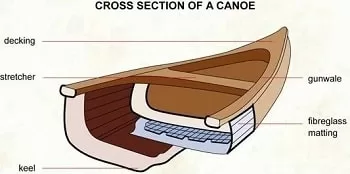
The gunwale can be made from various materials like vinyl, wood, plastic, or aluminum. It is an essential part of the canoe that adds structural integrity, customization options, and convenience to the canoeing experience.
Canoe Deck
The canoe deck is a triangular surface that covers the gunwales in the bow and stern of the boat. It strengthens the canoe’s tips in the bow and stern and often includes handles to make carrying the canoe easier.
The deck should be distinct from a canoe spray deck, with a flexible waterproof cover with waist-level openings for the passengers. The canoe deck can be made of metal, wood, or plastic.
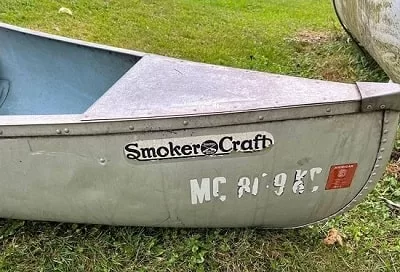
The canoe deck reinforces the structure of the canoe by adding strength and stability to the tips of the boat. It serves as a point of attachment for the gunwales, which secure the canoe’s sides and provides carrying handles for portaging and for canoe transportation.
Additionally, the deck helps keep water out of the canoe by acting as a barrier.
Canoe Spray Deck
A canoe spray deck is a malleable waterproof cover that attaches to the gunwales of a canoe and covers the open cockpit with holes for the passengers’ waists.
It repels water and keeps water from entering the boat, keeping the passengers warm and dry on foul weather days. The spray deck seals around the cockpit’s rim and each passenger’s torso, making a fairly watertight seal.
The deck can seal in several ways, including elastic fabric, a hem containing an elastic cord or drawstring, and both. The spray deck can help allow a canoeist to perform a roll and continue paddling without having to bail out.
It can also have features for safety and convenience, such as map and paddle pockets, access openings, and tie-down straps.
Canoe Seats
Bench Seats
Bench seats are a traditional and simple design commonly found in canoes. They are typically made from wood or molded plastic and provide a flat and firm seating surface.
Bench seats are easy to maintain and offer a stable and balanced seating position. However, they may provide less comfort or support than other seat types.
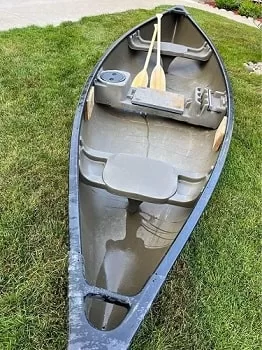
Webbed Seats
Webbed seats consist of woven webbing material stretched across a frame. They offer a lightweight and breathable seating option.
The webbing provides flexibility and conforms to the shape of the paddler’s body, offering comfort and support. Webbed seats are durable and can withstand exposure to water and weather conditions.
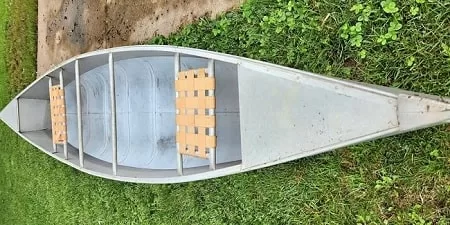
Bucket Seats
Bucket seats are contoured seats designed to cradle the paddler’s body. They offer a more ergonomic and supportive seating position, which can enhance comfort during long paddling trips.
Bucket seats are often made of molded plastic or composite materials and are typically found in solo canoes. They provide excellent stability and control, especially in rough water conditions.
Contoured Seats
Contoured seats are designed with a curved shape to provide optimal comfort and support. They are molded to fit the natural contours of the paddler’s body, offering a more customized and ergonomic seating experience.
Contoured seats are often preferred by paddlers who prioritize comfort during extended trips.
Canoe Rocker
The canoe’s hull’s curve in the bow and stern is known as a rocker. The amount of rocker affects the performance of the canoe in several ways. Canoes with more rocker are more maneuverable and easier to turn, making them ideal for whitewater paddling and navigating through obstacles.
Canoes with less rocker have better tracking and stability, making them ideal for flatwater paddling and long-distance trips. Canoes with more rocker are better at handling waves and rough water conditions, while canoes with less rocker are faster and more efficient.
Canoe Sides
- Tumblehome sides
Tumblehome sides curve inward toward the top of the canoe. They are usually found on wider hulls and provide a narrower width at the gunwale beam than the maximum beam.
The paddle stroke enhances force and efficiency due to tumblehome sides, making it simpler to get to the water and maintain the paddle practically parallel. However, they can let water in when paddling in rough waves.
- Flare sides
Flare sides have a wider width at the gunwale beam than the maximum beam, with the top of the canoe sides flaring out over the waterline.
They provide greater stability in rough waves and are popular for whitewater paddling. However, they can make reaching the water more difficult and keeping the paddle perpendicular to the water.
- Straight sides
Straight sides provide less secondary stability than other side shapes and are less popular than other side shapes. They are narrow in width as the side rises above the waterline, allowing for a more efficient stroke. They increase the power and efficiency of the stroke and provide greater stability in rough waves.
Canoe Handles
Canoe handles are an essential part of the canoe and are used for carrying and maneuvering the canoe.

- Handholds: Located at the bow and stern of the canoe, handholds are used for carrying the canoe upright with two people. They provide a secure grip and distribute the canoe’s weight, making it easier to lift and maneuver.
- Yoke: A yoke is a shaped piece of wood or metal placed across the canoe’s centre and used for carrying the canoe on the shoulders. It provides a comfortable and balanced grip for portaging or moving the canoe on land.
- Deck Handles: Deck handles are located at the tips of the bow and stern of the canoe. They provide a secure grip and help keep water out of the canoe. Deck handles also serve as carrying handles for the canoe.
Ribs
Ribs are shallow “U” shaped pieces that push outwards inside the canoe’s hull to add strength and rigidity. They provide hull rigidity and structural strength, helping maintain the canoe’s shape and prevent flexing or warping.
Belly
The belly of a canoe refers to the centerline of the canoe running from bow to stern. It provides a point of reference for the paddler and helps maintain the balance and stability of the canoe.
Floatation Chamber
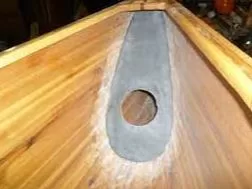
A floatation chamber is a sealed air compartment located at a canoe’s bow and stern ends. It prevents the canoe from sinking if it becomes filled with water.
Floatation chambers are important for safety, as they help keep the canoe afloat and provide buoyancy in case of canoe capsizing.
Parts of A Canoe Diagram
Parts of Canoes of Inside and Outside
| Outside Parts | Inside Parts |
|---|---|
| Bow | Ribs |
| Stern | Thwarts |
| Portside | Belly |
| Starboard Side | Keel |
| Beam | Floatation Chambers or Bulkhead |
| Gunwale | |
| Decks | |
| Pointers | |
| Canoe Trolling Motor |
What is the Beam on a Canoe?
A canoe’s beam, which describes its width, is typically measured across the gunwale’s widest point. It is an important measurement that impacts the stability and speed of the canoe.
The beam is usually provided in three measurements:
- Waterline: The waterline beam is the width of the canoe at the waterline
- Gunwale: The gunwale beam is the width of the canoe at the top of the gunwales
- Maximum width: The maximum width is the widest point of the canoe.
The canoe’s width affects the amount of effort required to push the water aside and the amount of friction the hull surface creates.
A narrow beam makes the canoe faster but less stable, while a wider beam makes the canoe more stable but slower.
The beam is an essential part of the canoe’s design and plays a crucial role in determining the performance and functionality of the canoe.
Do parts of a canoe differ in different types of canoe?
Recreational
Recreational canoes, such as calm lakes or slow-moving rivers, are designed for flat water. They are typically wider and more stable, making them suitable for casual paddling and family outings.
While the basic parts of a canoe remain the same, recreational canoes may have additional features like comfortable seats, storage compartments, and cup holders.
Expedition
Expedition canoes are built for long-distance trips and carrying heavy loads. They are designed to handle rough water conditions and have increased stability and storage capacity.
Expedition canoes may have reinforced hulls, extra flotation chambers for added buoyancy, and additional tie-down points for securing gear.
Whitewater
Whitewater canoes are specifically designed for navigating fast-moving rivers and rapids. They are highly maneuverable and have a more rounded hull shape for quick turns and agility.
Whitewater canoes may have reinforced hulls, added rockers for better maneuverability, and specialized outfittings such as thigh straps and flotation bags for enhanced control and safety in turbulent water.
Racing
Racing canoes are built for speed and performance in flatwater racing events. They are long, narrow, and lightweight to maximize speed and efficiency.
Racing canoes may have sleek, streamlined hull designs, minimal rockers for improved tracking, and specialized seating configurations for optimal paddling technique.
Which canoe parts Affect Stability and Maneuverability (and How)?
Rocker
Rocker is the curve in the hull from bow to stern, viewed from the side of the canoe. Increased rocker allows the ends of the canoe to rise more easily when meeting waves, making the canoe more maneuverable in rough water conditions. Canoes with no rocker (flat keel lines) track straight but are harder to handle.
Chine
Chine is the angle where the bottom of the canoe meets the sides. Canoes with hard chine have a more angular shape and provide greater initial stability.
Compared, canoes with soft chine have a more rounded shape and provide greater secondary stability and agility.
Beam
The beam is the width of the canoe, typically measured across the widest point of the gunwales. A narrow beam makes the canoe faster but less stable, while a wider beam makes the canoe more stable but slower.
The canoe’s width affects the amount of effort required to push the water aside and the amount of friction the hull surface creates.
Changes in Canoe Parts (and overall design) Over Fast Few Years
It is impossible to determine who invented the canoe due to its ancient history, and it is mostly believed it was developed independently by prehistoric people worldwide.
Canoe construction has evolved over time, resulting in lighter, stronger, and faster canoes. This has been made possible by using materials with high strength-to-weight ratios, such as carbon and Kevlar.
New manufacturing techniques, such as reduced fabric weight and vacuum bagging/resin infusion, have also reduced weight. Canoe design varies among manufacturers, with some prioritizing stability and others focusing on maneuverability.
The length of the canoe affects its speed, while the angle of the sides affects stability and ease of paddling. Using new materials and manufacturing techniques has allowed canoe builders to create more comfortable and efficient designs.
Additional features like bulkheads, which divide the canoe’s interior into separate compartments, and properly attached seats contribute to the overall performance and safety.
What’s the best Hull Design?
For Racing Canoes:
A V-shaped hull is designed for speed and efficiency. It has a deep V shape allows it to cut through the water with minimal resistance.
For Touring Canoes:
Shallow vee hulls have a more pronounced V shape than shallow arch hulls. They offer good tracking and stability, making them suitable for flatwater paddling and touring.
For Recreational Canoes:
Flat bottom hulls offer excellent initial stability, making them highly stable on calm water. However, they can be vulnerable to wind, waves, and leaning and are less suitable for rough water conditions.
For Canoes That Require Stability And Efficiency
Rounded hulls provide increased secondary stability and are better suited for rough water conditions. Their curved shape helps the canoe ride over waves and maintain stability. This hull design is often preferred for fishing or paddling in choppy waters.
Shallow arch hulls balance stability and maneuverability. They have a slight curve that offers good initial stability and allows for easy turning. This hull design is versatile and suitable for various conditions, including recreational paddling and fishing.
What is Tumblehome on a Canoe?
Tumblehome is a design technique used in canoe construction that refers to the inward curve of the sides of a canoe at the gunwales. Using this method, the canoe’s sides are drawn in at the gunnels so paddlers can perform a good vertical forward stroke and get to the water more quickly.
This is crucial for a broad canoe’s bow paddler in particular. Tumblehome is most evident in solo designs.
Tumblehome has several functions in canoe design.
- It allows paddlers to reach the water more easily with a proper vertical forward stroke, improving efficiency and speed.
- It also makes paddling close to the hull easier, improving stability and control.
However, a canoe with an extreme tumblehome may become unstable when tilted excessively.
Buoyancy is mainly influenced by which part?
Buoyancy refers to the ability of a canoe to float and stay afloat in the water, and some important canoe parts influence it.
- Flotation Chambers:
Flotation chambers are sealed air compartments at a canoe’s bow and stern ends. They prevent the canoe from sinking if it becomes filled with water and provide buoyancy in case of capsizing. Flotation chambers are important for safety, as they help keep the canoe afloat and provide buoyancy.
- Bulkheads:
Bulkheads are walls or partitions that divide the canoe’s interior into separate compartments. They provide additional buoyancy and stability by preventing water from sloshing inside the canoe. Bulkheads are commonly found in sea kayaks and ocean canoes.
- Hull Design:
The hull design of a canoe can also influence buoyancy. Canoes with a flat hull design have less buoyancy and are less stable than canoes with a shallow arch or shallow vee hull design. Canoes with a shallow arch or vee hull design have more buoyancy and stability.
FAQs
How do Flotation Devices bring safety to your canoe structure?
Flotation devices in canoes provide buoyancy, prevent sinking, and aid in rescue and recovery from capsizing or swamping.
What is the significance of the canoe rocker in terms of maneuverability?
A canoe with no rocker tracks straight but is harder to maneuver. A moderate rocker allows for easy turning and good tracking. Canoes with many rockers are easier to turn and maneuver but harder to keep on track when paddling in a straight line.
Is a Canoe Symmetrical?
A canoe can be symmetrical, depending on the design and intended use. Some canoes are designed to be symmetrical, while others are asymmetrical. The shape of the sides of a canoe may vary throughout the length of the hull, and the three basic side profiles are flared, straight, and tumblehome.
How does the gunwale or gunnel design impact the canoe’s stability and performance?
The gunwale design provides structural stability, prevents flexing or twisting, and offers attachment points for accessories. It affects the canoe’s stability and handling through its stiffness, attachment points, and material choice.
What is the significance of ribs or thwarts in traditional canoe construction methods?
Thwarts and ribs provide hull rigidity and structural strength, preventing flexing or warping. Thwarts prevent the canoe from flexing or twisting under load, while ribs support the canvas or other materials used to cover the canoe. Notching the stems to accept at least three full ribs ensures that the ends of the canoe are securely connected to the center portion of the hull.

Jack Bennett, a passionate pedal boating enthusiast, and marine engineer by day, is here to share my knowledge and love for this exciting sport with you all. Happy Boating!
